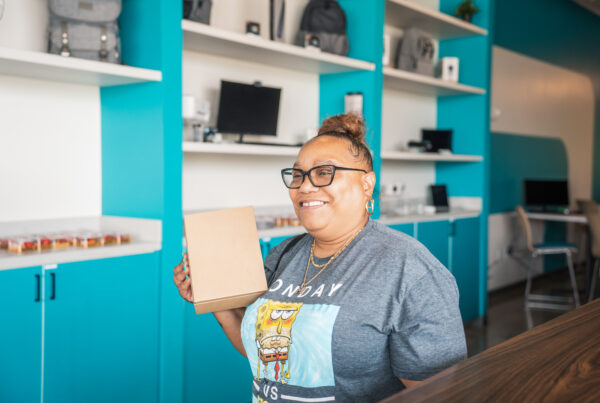Finding high-quality affordable internet in Los Angeles is a challenge for most of its residents. This is a shame, as this is a city renowned for its technological advancements and cultural diversity, yet a silent profound digital divide persists.
This divide separates those with ready access to the internet and digital technology from those without. In a society increasingly reliant on digital connectivity, this gap is a massive barrier to education, employment, and essential services. It’s a divide that disproportionately affects low-income households and communities of color, leaving them at a significant disadvantage in an ever-evolving digital world.
At Human-I-T, we recognize that addressing this connectivity divide is more than just providing affordable internet; it’s about ensuring everyone, regardless of income, has equal access to technology and the internet.
A Quick Recap About the Digital Divide in Los Angeles
The Current State of Internet Accessibility
In Los Angeles County, the digital landscape presents a stark contrast between connectivity and isolation. Approximately 265,000 households lack a home computer, a fundamental tool for navigating today’s digital world. This gap widens as we consider that 311,000 households rely solely on cellphone internet, a solution that often falls short of providing comprehensive online access.
The situation is even more dire for the 416,000 households completely devoid of internet access. These figures are not just numbers; they represent a significant portion of the population sidelined in a rapidly advancing digital era.
The Impact on Education and Employment
The repercussions of this digital divide ripple through crucial aspects of life, notably education and employment. The Los Angeles Unified School District (LAUSD) has identified that around 20% of its students, equating to about 90,000 children, are either entirely without broadband service or have insufficient bandwidth for their academic needs. This digital scarcity hinders their current educational progress and their future prospects in an increasingly digital job market.
The LAUSD’s $50-million initiative to provide adequate internet for all families is a testament to the urgency of this issue. However, it also underscores a broader societal challenge: bridging the digital divide is about ensuring equal opportunities for growth and development.
Addressing the divide is imperative, not only for individual advancement but for the collective progress of our communities. The lack of affordable internet in Los Angeles and across the nation, as well as gaps in digital access for many communities, paves the way for exploring innovative solutions and collaborative efforts to ensure that the digital world is an inclusive one.
A Look at the Options for Affordable Internet in Los Angeles
In Los Angeles, the concept of affordable internet is often at odds with the economic realities of its residents.
While access to affordable internet in LA has grown steadily in recent years, the financial burden of these services remains a significant hurdle, especially for low-income families.
Have a quick look at the top internet providers in the Los Angeles area and you’ll easily see how they may not be affordable at all for many.
AT&T Fiber
- Pros: Symmetrical speeds up to 5,000 Mbps, no data caps, and no equipment rental fee.
- Cost & Accessibility: Plans start at $55/month for 300 Mbps. AT&T Fiber’s lack of setup fees and equipment rental charges might offset some cost barriers
- Contracts & Setup: No term agreements required, potentially lowering the barrier for families wary of long-term financial commitments.
- Coverage: While offering some of the fastest speeds, AT&T Fiber’s coverage is not uniform across Los Angeles
Spectrum
- Pros: Broad coverage across Los Angeles, with speeds up to 1,000 Mbps.
- Cost & Accessibility: Introductory prices start at $49.99/month for 100 Mbps, but prices increase after 12 months. Spectrum’s no-contract policy is a plus.
- Contracts & Setup: Spectrum promotes no contracts, which is beneficial for families not wanting long-term commitments.
- Coverage: Spectrum’s extensive coverage in Los Angeles makes it a viable option for many.
Starry Internet
- Pros: Simple, all-inclusive pricing and fast speeds.
- Cost & Accessibility: A flat rate of $50/month for up to 200 Mbps, with no hidden fees, offers clarity in pricing. However, its limited availability restricts options for many families.
- Contracts & Setup: Starry’s no-contract approach and absence of setup fees make it an attractive option for renters and those in serviced buildings, emphasizing ease of access and affordability.
- Coverage: Restricted to specific buildings, Starry’s innovative technology offers high-speed internet but lacks the broad accessibility needed to serve all low-income families in Los Angeles.
Frontier
- Pros: Offers the cheapest fiber plan among major providers, with high-speed internet at affordable prices and multi-gig plans up to 5,000 Mbps.
- Cost & Accessibility: Frontier’s fiber plans start at an appealing price point, with the Fiber 500 plan beginning at $49.99/month, offering a significant value for the speed. With unlimited data, no contracts, and included equipment, Frontier addresses several cost barriers at once.
- Contracts & Setup: No contracts required and equipment included in the monthly price reduce initial costs and long-term commitments.
- Coverage: While offering competitive speeds and prices, Frontier’s fiber internet’s reach within Los Angeles may be limited to certain areas.
T-Mobile Home Internet
- Pros: Utilizes 5G and 4G LTE networks to provide home internet service, offering simplicity in plans and pricing.
- Cost & Accessibility: Priced at $60/month ($50 for T-Mobile wireless customers), this service includes all equipment, taxes, and fees, with no data caps. This straightforward pricing can be advantageous for budgeting purposes.
- Contracts & Setup: No contracts and no setup fees promote flexibility and ease of adoption for households wary of long-term financial obligations.
- Coverage: While technically available throughout the Los Angeles metro area, the quality of service heavily depends on T-Mobile’s network strength in specific locations, making it a variable option.
Cox Communications
- Pros: A significant player with a variety of plans catering to different needs.
- Cost & Accessibility: Starting at $50/month for 100 Mbps, Cox offers a range of options.
- Contracts & Setup: Contracts are not required for the lowest promo rate, offering some flexibility
- Coverage: Cox’s presence in Los Angeles is limited to specific areas like the Palos Verdes Peninsula.
Unfortunately, in a place in LA, a single person earning $70,650 is now considered low income. More worrying is that more than 50% of residents fall into this low-income bracket, meaning that the costs of these plans are often still too high for most Angelenos to comfortably afford.
In this context, the efforts by governments and nonprofits like Human-I-T to provide affordable internet in Los Angeles emerge as crucial steps toward bridging the county’s digital divide.
The Role of Policy and Community Efforts
Government Initiatives and Their Limitations
Government initiatives have played a pivotal role in addressing the digital divide, with programs like the Affordable Connectivity Program (ACP) leading the charge. The ACP, a successor to the Emergency Broadband Benefit program, has been instrumental in subsidizing household internet bills, offering up to $30 per month for eligible households. However, despite its impact, the ACP’s reach has been limited. As of April 2023, only 36% of over 8 million eligible households in California had enrolled, highlighting a gap between the program’s potential and its actual uptake.
The impending conclusion of the ACP marks a significant moment for internet accessibility in America. While current beneficiaries will continue to receive benefits until the funds run out, estimated in April 2024, the window for new applicants is now closed. This reality underscores the need for continued efforts and innovative solutions to preserve and build upon the gains made in digital inclusion.
The Power of Cross-Agency Collaboration
In contrast to the limitations of federal initiatives, local collaborations in Los Angeles County exemplify the power of community-driven efforts. The synergy between the County’s Internal Services Department (ISD), Department of Parks and Recreation, and Public Library System has been a beacon of progress. These agencies have unified their resources to enhance digital literacy and provide tech resources to communities lacking access.
Programs like the Laptop Lending initiative and expanded Wi-Fi capabilities in public parks demonstrate how cross-agency collaboration can effectively address the digital divide. These efforts not only provide immediate solutions but also lay the groundwork for sustainable digital inclusion. As Los Angeles moves forward, the success of these collaborations serves as a model for other communities, showcasing the potential of local initiatives to make a tangible difference in bridging the digital divide.
The journey towards digital equity continues, with the role of policy and community efforts being more crucial than ever. As we transition to the next phase of digital inclusion, the focus shifts to fostering environments where every individual has access to the digital tools they need to succeed.
Getting Affordable Internet in Los Angeles After the ACP Ends
Human-I-T offers a lifeline for low-income residents in Los Angeles, providing essential services that go beyond typical offerings from internet service providers. Our approach is tailored to the needs of those most affected by the digital divide:
Affordable Internet Access: Through its Gold Membership, Human-I-T lets individuals access high-speed internet for $15 per month. This includes the option to purchase a Franklin T10 4G mobile hotspot with unlimited LTE connectivity for up to 10 devices.
Digital Literacy and Support: Recognizing that access alone isn’t enough, Human-I-T provides digital literacy training and tech support. This empowers users not just to connect, but to utilize digital tools effectively for education, job searching, and personal growth.
Device Accessibility: Human-I-T also addresses the need for affordable computers. By offering refurbished laptops and tablets at significantly reduced prices, they ensure low-income households have access to necessary technology.
In a city where the cost of living continually outpaces income growth, Human-I-T’s services are more than just a convenience; they are a crucial step towards digital equity. By providing affordable, accessible, and usable digital solutions, Human-I-T is actively working to diminish the digital divide in Los Angeles, offering a sustainable path to connectivity for those who need it most.






